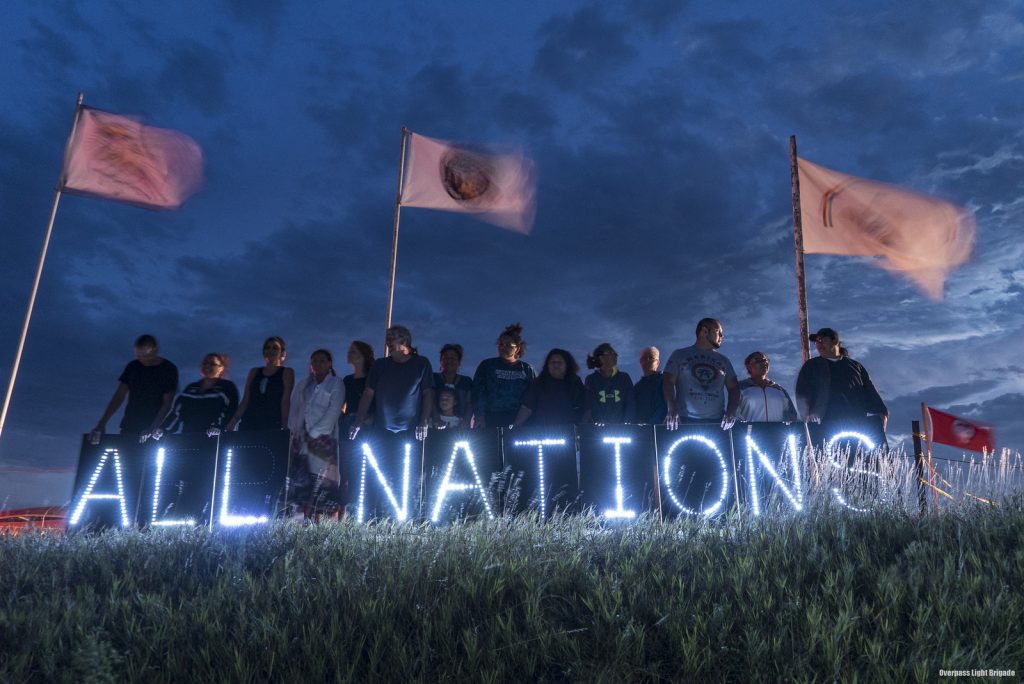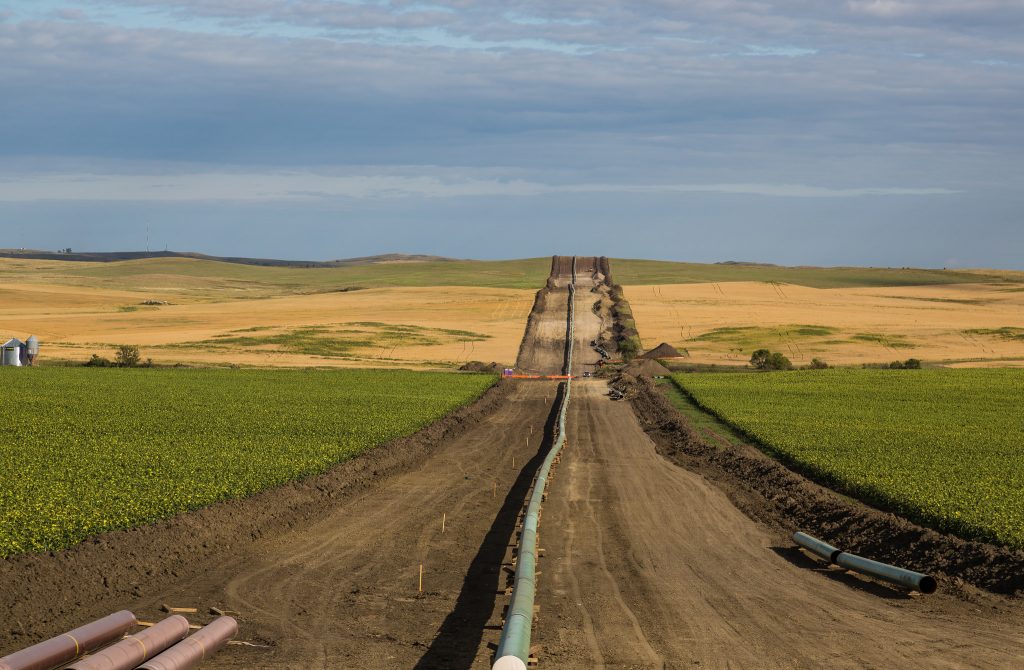North Dakota Access Pipeline Protests Spark Historic Declaration

Several branches of the U.S. government have issued what is being called a historic declaration about the need for a serious discussion on national reform of Native American tribal consultation during major infrastructure projects. The September 9 announcement was spurred by protests over an oil pipeline being built in North Dakota.
Since April, thousands of demonstrators have gathered to protest the North Dakota Access Pipeline Project, the installation of about 1,172 miles of pipeline that would carry crude oil from North Dakota to Illinois. The pipeline, much of which has already been built by Dakota Access LLC, is scheduled to pass within half a mile of the Standing Rock Sioux reservation. The Standing Rock Sioux have complained about the destruction of their sacred sites by construction, the possible contamination of the Missouri River by future leaks, and what they see as a lack of meaningful consultation with the tribe.
The protests are the latest in a long tradition of Native American activism, including recent protests against the TransCanada Keystone XL pipeline. In late July, the Standing Rock Sioux tribe asked for a temporary injunction against work on the North Dakota pipeline, claiming that the U.S. Army Corps of Engineers hadn’t consulted with the tribe sufficiently; the corps is responsible for issuing permits for construction around waterways, which comprises about 3.5 percent of the pipeline, including in the Sioux’s sacred lands. On September 9, the injunction was denied by a federal judge who said the corps had “likely complied” with federal rules.
But that court decision was overridden moments later by a joint announcement from the U.S. Department of Justice, the Department of the Army, and the Department of the Interior, calling for a halt on construction in the contentious area around Lake Oahe. The announcement also called for a meeting this fall between tribes and the government about the consultation process for such projects.
The Standing Rock Sioux tribe called the announcement “stunning.” And they are still pressing forward with their request for an injunction. “Our hearts are full, on this historic day for the Standing Rock Sioux tribe and for tribes across the nation,” said Dave Archambault II, chairman of the Standing Rock Sioux tribe.
The protests against the Dakota Access pipeline have been supported by celebrities, members of dozens of other tribes, and numerous organizations including the American Anthropological Association (AAA), which said in a statement that the pipeline “violates the cultural and collective environmental human rights of the tribe to life, land, cultural preservation, health, clean water, and a clean environment.”
“I don’t know what’s most pressing,” says Richard “Richie” Meyers, president of the Association of Indigenous Anthropologists, part of the AAA. Meyers, a cultural anthropologist at South Dakota State University, is an Oglala Sioux tribal member. “Water is a huge issue across the country. And consultation is always an issue. It’s no different than it’s always been; it’s kind of the narrative of America.”
The Standing Rock Sioux tribe uses the banks of the Missouri River for spiritual ceremonies, and the river, as well as Lake Oahe, “plays an integral role in the life and recreation of those living on the reservation,” wrote the judge in setting the context for his decision.
The threat of water contamination from pipeline leaks is a serious concern. Although studies have shown that pipelines are generally safer than trucks and spill less oil overall, individual spills from pipelines can be larger and often go unreported. A pipeline leak in North Dakota in September 2013, for example, spilled about 20,600 barrels. “It’s not a matter of if [a pipeline leaks], it’s when,” says Meyers.
In part because of such concerns, the U.S. Environmental Protection Agency recommended in March that the corps revise their environmental assessment of the area (the Department of the Interior agreed).
The question of whether sacred sites are being destroyed by the pipeline’s construction is more complicated. The judge notes that the path chosen for the pipeline goes almost exclusively through private lands (where the corps does not issue permits) and land that has already-existing utility lines. The Dakota Access project sought to avoid areas listed on or potentially eligible for inclusion on the National Register of Historic Places, he wrote. The pipeline route was modified 140 times in North Dakota alone to avoid potential cultural resources, including 91 identified stone features.
Nevertheless, Tim Mentz Sr., the former Standing Rock Sioux tribal historic preservation officer, has filed a number of court documents outlining sites of cultural significance in or near the construction zone. On September 2, for example, Mentz detailed rock cairn burial sites he could see from private lands on the west side of Lake Oahe. (He did not have permission to go inside the construction corridor itself.) This included a stone circle called an Iyokaptan Tanka (Big Dipper), which he recognizes as the burial site of an important leader, some 75 feet outside the construction corridor. “This is one of the most significant archeological finds in North Dakota in many years,” Mentz wrote.
The pipeline corridor area surveyed at a distance by Mentz was bulldozed by the construction crew the next day, over a holiday weekend. “Even without a formal damage assessment, my conclusion from what I have been able to see is that any site that was in the pipeline corridor has been destroyed,” Mentz wrote in another court document. Sites just outside the corridor may also have been buried in soil. Unmarked burial sites are protected under North Dakota state law.
Neither the Tribal Historic Preservation Office nor Dakota Access LLC responded to requests from SAPIENS for comment.
The State Historic Preservation Office Chief Archaeologist Paul Picha told SAPIENS that the entire pipeline corridor was surveyed by accredited archaeologists at some point and that he saw no sites in the reports from the area that Mentz surveyed. “We were comfortable that due diligence was done,” says Picha.
However, the Advisory Council on Historic Preservation, based in Washington, D.C., took issue with the corps’ conclusions about a lack of historic sites in the area and noted that consultation with the tribes didn’t seem sufficient. The judge disagreed about the corps’ efforts at consultation, writing that the corps had documented dozens of attempts to consult with the Standing Rock Sioux.
Regardless of whether consultation was legally sufficient, the protests have pushed U.S. government departments to say they might reconsider their rules. “The decision by the federal agencies to halt any additional permitting and reconsider its past permits is a game-changer,” wrote EarthJustice, a nonprofit environmental law organization that has been assisting the Standing Rock Sioux. “The administration will revisit the whole way in which the government interacts with Indian tribes on major projects like this one, as we have long advocated.”


































